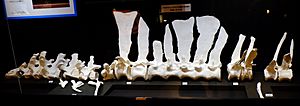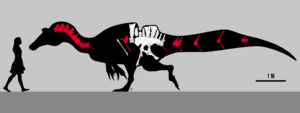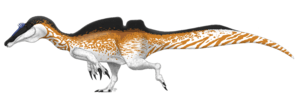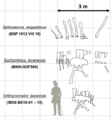Ichthyovenator facts for kids
Quick facts for kids Ichthyovenator |
|
|---|---|
 |
|
| Casts of the type vertebrae in side view | |
| Scientific classification |
|
| Kingdom: | Animalia |
| Phylum: | Chordata |
| Clade: | Dinosauria |
| Clade: | Saurischia |
| Clade: | Theropoda |
| Family: | †Spinosauridae |
| Subfamily: | †Spinosaurinae |
| Genus: | †Ichthyovenator Allain et al., 2012 |
| Type species | |
| †Ichthyovenator laosensis Allain et al., 2012
|
|
Ichthyovenator was a large meat-eating theropod dinosaur. It lived during the Early Cretaceous period. This was about 113 to 125 million years ago. Its fossils were first found in Laos in 2010. Ichthyovenator belonged to a group called spinosaurids. These dinosaurs were often crocodile-like and mostly ate fish.
It is one of only three spinosaurids found in Asia. The other two are Siamosaurus and "Sinopliosaurus" fusuiensis.
Contents
Discovering Ichthyovenator
The first parts of the Ichthyovenator skeleton were found in 2010. These parts included a rib, a vertebra (part of its backbone), and most of its hip bones. Scientists did not find the skull at this time.
The only known species of this dinosaur is Ichthyovenator laosensis. It was officially named and described by Ronan Allain and his team in 2012. The fossils were discovered in a rock layer called the Grès supérieurs Formation.
The name Ichthyovenator comes from two ancient words. "Ichthyo" is Greek for "fish." "Venator" is Latin for "hunter." So, its name means "fish hunter." This name shows that it probably ate fish. The species name, laosensis, means "from Laos." This is because it was found in the country of Laos.
While Ichthyovenator was being studied, paleontologists kept digging for more bones. Ronan Allain, one of the original describers, later shared news in 2014. He said that more of Ichthyovenator's skeleton was found in 2012. These new bones included several teeth, a hip bone, most neck bones, and some back and tail bones. However, these new discoveries have not yet been fully described in a scientific paper.
In 2015, some of Ichthyovenator's bones were compared to those of Sigilmassasaurus. Sigilmassasaurus is another type of spinosaurid dinosaur.
What Ichthyovenator Looked Like

Scientists believe Ichthyovenator was about 8.5 meters (about 28 feet) long. This makes it similar in size to Baryonyx, one of its close relatives.
A very special feature of Ichthyovenator was a large "sail" or hump on its back. This sail was about half a meter (1.6 feet) tall. Other spinosaurids like Suchomimus and Spinosaurus also had sails. But Ichthyovenator's sail was unique because it was split into two parts near its hips. Scientists are still not sure why its sail was shaped this way.
Ichthyovenator's Family Tree
When Ichthyovenator was first discovered, it was placed in the spinosaurid family. Specifically, it was thought to be part of the subfamily called Baryonychinae. This group includes dinosaurs like Baryonyx and Suchomimus.
However, in 2014, new studies suggested something different. Scientists found that Ichthyovenator might actually belong to the subfamily Spinosaurinae instead. This idea came from looking closely at its teeth and how its backbones looked similar to those of Sigilmassasaurus.
Some people have suggested that Ichthyovenator might not be a spinosaurid at all. They think it could be a different type of dinosaur called a carcharodontosaurid. They even thought it might be related to Concavenator, which also had a sail-like structure. But this idea has not been formally published in scientific journals.
Scientists use diagrams called cladograms to show how different dinosaurs are related. Here is a simplified family tree showing where Ichthyovenator fits with some other dinosaurs:
| Spinosauroidea |
|
||||||||||||||||||||||||||||||||||||||||||||||||
Images for kids
-
Casts of the vertebrae at the Muséum National d'Histoire Naturelle, Paris
-
Casts of the known spinal column at the National Museum of Nature and Science, Tokyo. The thirteenth dorsal spine and the lower part of the sacrum have been partially reconstructed.
-
Comparison of the pelvic region and neural spine sails of Suchomimus, Spinosaurus, and Ichthyovenator
-
Reconstructed skeleton of the spinosaurine Irritator, mounted at the National Museum of Nature and Science, Tokyo
-
Ichthyovenator might have used its tail, which had elongated neural spines, for propulsion through water, similar to crocodilians such as this Nile crocodile
-
Fossils of the sauropod Tangvayosaurus, another dinosaur from the Gres superieurs Formation, Savannakhet Dinosaur Museum









